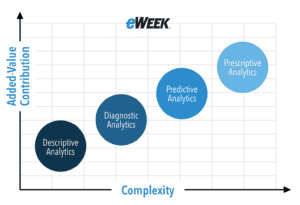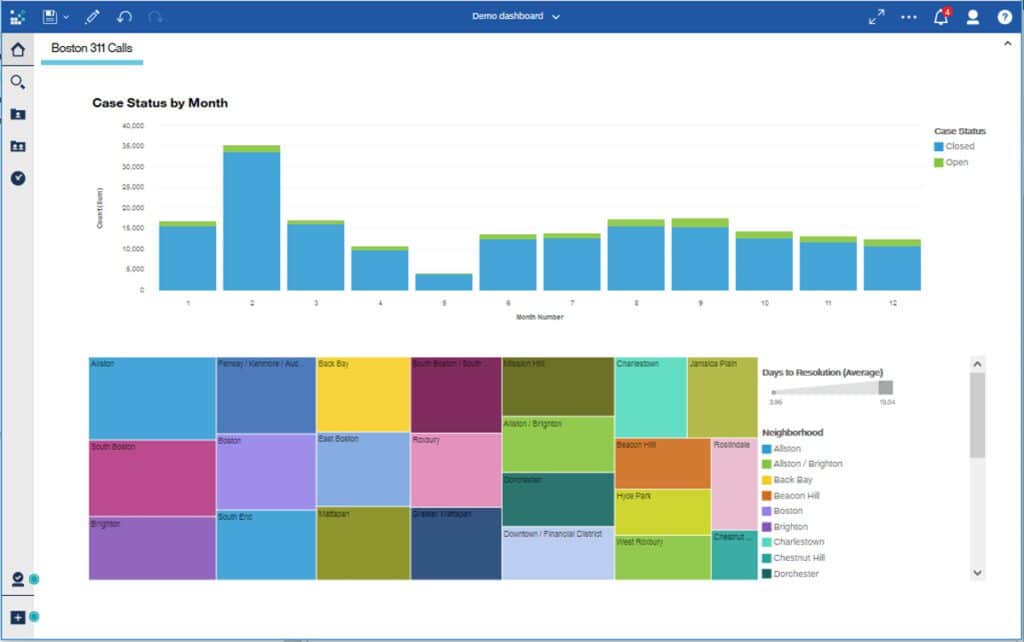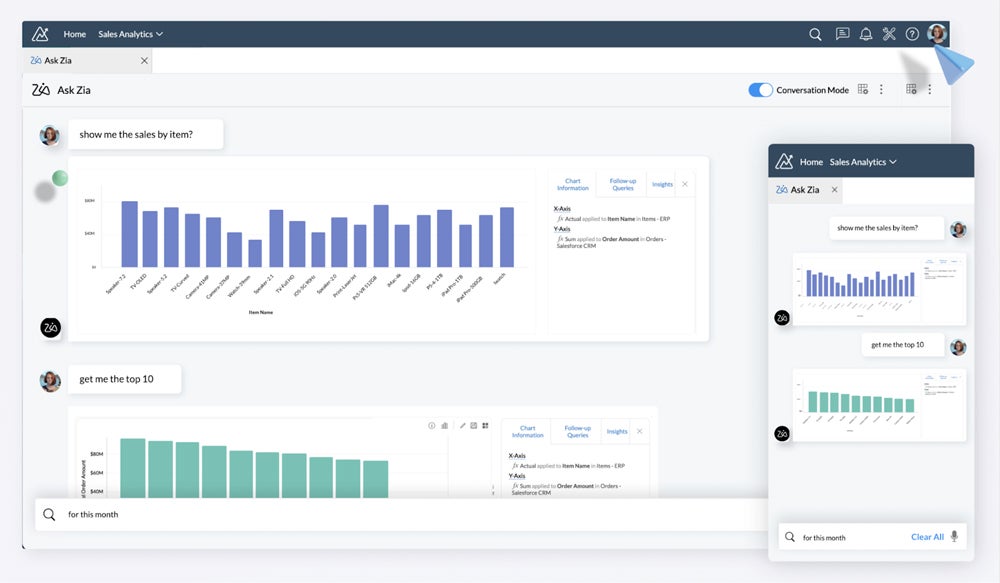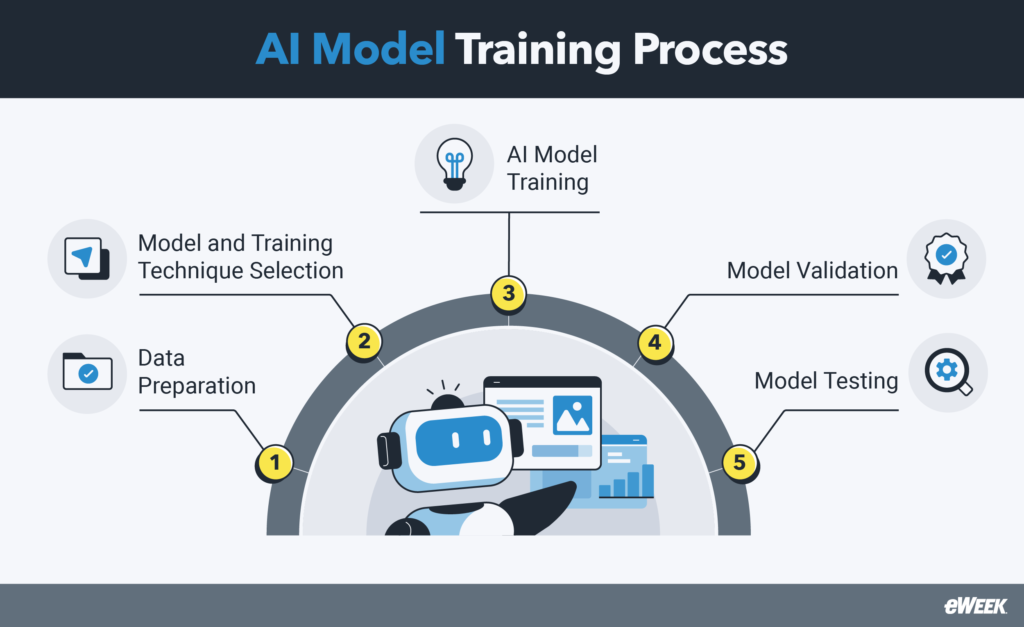Knowledge analytics is the computational evaluation of information, statistics, or different types of data to extract data, patterns of habits or different types of actionable perception.
By information analytics, numerous insights might be gained. Some examples embrace, however are usually not restricted to:
- Noticing explicit occasions and days the place gross sales spike or crater.
- Uncovering uncommon community exercise, which could possibly be a sign of hackers.
- Figuring out functions that use an inordinate quantity of system sources.
- Noticing adjustments in buyer/client visitors because of exterior influences.
Knowledge analytics is all about higher choice making. This advanced course of is carried out primarily by information analysts and information scientists, however in some circumstances and with the best instruments it may be accomplished by non-tech workers as nicely. The method usually begins with uncooked information, which is information mined, in search of beneficial perception – certainly, aggressive benefit is the aim of enterprise information analytics.
To higher perceive information analytics, leap to the next subjects:
- The Significance of Knowledge Analytics
- Sorts of Knowledge Analytics
- Advantages of Knowledge Analytics
- Challenges of Knowledge Analytics
- Knowledge Analytics and AI
- Knowledge Analytics Suppliers
- Knowledge Analytics Certifications
- Knowledge Analytics vs. Knowledge Science
- Backside Line: The Way forward for Knowledge Analytics
The Significance of Knowledge Analytics
As digital transformation has gained adoption, the apply of information analytics has skyrocketed. It doesn’t matter what trade you’re employed in, information analytics seemingly performs a key function in crafting your technique. Many corporations now have information analysts utilizing information mining strategies on uncooked information – in search of the various actionable insights gained from this course of.
In response, the marketplace for information analytics software program has climbed quickly. In response to IDC, worldwide spending on large information and enterprise analytics options will climb 10.1 % in 2021 to succeed in $215.7 billion. Corporations are hiring information scientists and information analysts at a gentle clip. The mantra now could be “data-driven choice making.”
And it’s price noting that funding in information analytics didn’t drop off even within the darkest days of the worldwide coronavirus pandemic. “Not like many different areas of the IT providers market, large information and analytics providers continued to develop in 2020 as organizations relied on information insights and clever automation options to outlive the COVID-19 pandemic,” stated Jennifer Hamel, a analysis supervisor at IDC. “The following part of digital resiliency will spur elevated funding in providers to deal with each lingering and new challenges associated to enterprise intelligence initiatives.”
These rising significance of information analytics encompasses a variety of actions which might be widespread in fashionable enterprises. For instance, information analytics can embrace lots of the following:
- Knowledge mining
- Textual content analytics
- Knowledge visualization
- Enterprise intelligence
- Knowledge Catalogs
- Knowledge warehouses
- Knowledge lakes
- Knowledge material
- Knowledge modeling
- Synthetic intelligence (AI)
- Machine studying (ML)
- Deep studying
As well as, a variety of disciplines make use of information analytics and various large information traits, from finance to accounting to product administration to manufacturing. And an array of associated actions and applied sciences play a task, together with information visualization and relational databases, usually utilizing massive datasets.
Knowledge analytics is integral to analysis and improvement, engineering, and strategic planning. And naturally it’s the very coronary heart of logistics and provide chain administration. With yearly, analytics performs a bigger function in data know-how and cybersecurity. In sum, there’s hardly an trade that isn’t pushed by information analytics.
At this time, many organizations have a chief information officer whose job it’s to supervise all points of information administration throughout the group, together with information analytics and information science.
Sorts of Knowledge Analytics
Not all information analytics are the identical. Most consultants divide information analytics into 4 key varieties, together with descriptive, diagnostic, predictive and prescriptive.
Descriptive analytics describes what occurred up to now or what’s presently taking place. The sort of analytics solutions questions like who, what, the place, when and the way. For instance, a gross sales report that exhibits your month-to-month gross sales over the previous 4 quarters is an instance of descriptive analytics. That is the simplest kind of research to carry out, nevertheless it has solely restricted worth to the group. You possibly can’t depart it out, nevertheless, as a result of descriptive analytics is a crucial basis for the extra superior varieties of analytics.
Diagnostic analytics tells you why one thing occurred. For instance, in case your descriptive analytics knowledgeable you that gross sales dropped final quarter, diagnostic analytics would assist you determine what went improper. The sort of analytics normally entails combining a number of information units to create a extra full and correct evaluation of your scenario. Possibly your gross sales drop occurred due to provide chain issues or unhealthy climate or since you misplaced a key account after hiring a brand new salesperson. Diagnostic analytics might help you work that out.
Predictive analytics helps you perceive what’s prone to occur subsequent. It takes a take a look at historic traits, on the lookout for patterns that can supply insights into the longer term. Typically predictive analytics instruments depend on superior information fashions and machine studying know-how that may distill the vital components that impacted previous efficiency and apply these to the present scenario. It is a rather more superior and speculative type of analytics with a excessive potential worth. It’s changing into a quite common device, notably for big enterprises.
Prescriptive analytics makes an attempt to let you know what it’s best to do about what’s prone to occur sooner or later. For instance, in case your predictive analytics forecasts decrease gross sales for subsequent quarter, prescriptive analytics might help you see how that may change when you decrease your costs or change your advertising and marketing technique or supply product from a distinct provider. Clearly, the potential profit with prescriptive analytics is extraordinarily excessive, however it is usually very tough to do prescriptive analytics nicely. At present few organizations have the sources and capabilities to do prescriptive analytics at scale.
Most organizations begin their information analytics journey with descriptive analytics. Over time, they develop into diagnostic analytics, then predictive analytics. Many aspire to finally have a profitable prescriptive analytics program to raised inform their enterprise decision-making.
 A comparability of the varied varieties of information analytics.
A comparability of the varied varieties of information analytics.
Additionally see: Actual Time Knowledge Administration Tendencies
Advantages of Knowledge Analytics
Most consultants agree that information analytics is tremendously vital for contemporary organizations as a result of it helps them turn out to be extra aggressive. Organizations undertake information analytics – utilizing utilizing information analysts – for numerous causes. A few of the commonest issues you are able to do with information analytics embrace the next:
Higher Perceive your Clients
Most organizations have entry to all kinds of information about their prospects, together with demographics, order historical past, customer support interactions, social media, searching historical past, survey responses and extra. Using information analysts to analyzing this information might help corporations create a fuller image of every particular person buyer in addition to an combination image of their prospects as an entire. As well as, it’d spotlight alternatives to raised meet buyer wants or attain new teams of consumers.
Streamline Enterprise Operations
Most of the processes inside your group, from order taking, to success, to provide chain administration, to customer support, to IT operations and extra are measurable. And something you possibly can measure, you possibly can enhance. Knowledge analytics might help you observe progress in direction of key efficiency indicators (KPIs) and allow you to determine bottlenecks that is likely to be slowing your group at the moment.
Determine New Alternatives
One of many extra fascinating areas of information analytics is the self-discipline of whitespace analytics. This apply helps organizations determine enterprise that they aren’t doing at the moment that they could possibly be doing. It might probably allow you to discover new prospects, new merchandise and new partnerships to pursue that might improve income and margins.
Capitalize on Current Tendencies
Even essentially the most fundamental information visualizations make it straightforward to see which path KPIs are shifting and at what price. By figuring out these traits – usually sifting by way of uncooked information – you are able to do extra of the issues which might be working nicely and try and right issues which might be heading the improper means.
Market Extra Successfully
Advertising and marketing is without doubt one of the enterprise disciplines that has been most reworked by information analytics. As a result of a lot advertising and marketing takes place digitally, advertising and marketing groups have a wealth of information obtainable that may assist them determine which targets are almost certainly to turn out to be prospects, which prospects are seemingly to purchase once more, which prospects are at risk of defecting to a competitor and rather more. They usually use information visualization to assist information mine for enterprise perception.
Enhance your Pricing Technique
What if enhancing your costs by simply 1 % can improve your group’s general margins by as a lot as 10 %? Analytics might help you analyze the variables. Knowledge analytics might help pricing groups determine the place they need to improve costs (and the place they need to lower them) in an effort to maximize profitability.
Make Higher Selections
People are at all times tempted to make choices for emotional causes, usually primarily based on preconceived notions that will or will not be true. Knowledge analytics gives a robust examine to this intuition in order that enterprise leaders can see whether or not their intestine reactions are prone to end in success or not. In a really broad sense, information analytics might help companies enhance their decision-making throughout all the group.
Challenges of Knowledge Analytics
Like each know-how resolution, information analytics has its challenges for anybody who chooses to embrace it. They embrace lack of educated workers, and difficulties with information visualization.
Lack of Skilled Professionals
Analytics, large information, and AI are all rising applied sciences which have solely begun to essentially take maintain in the previous couple of years. That signifies that the coaching and training behind them can be lack even additional. Many universities are placing collectively undergraduate and graduate applications and technical training establishments like CompTIA and Coursera have additionally made an effort to get folks educated. However there’s nonetheless a scarcity of expertise, for quite a lot of causes, equivalent to value for training. The scarcity just isn’t seen being alleviated anytime quickly.
Getting the Determination-Makers Onboard
Enterprise models inside an organizations could all be in the identical boat however all too usually don’t assume that means. In response to analysis from Forbes Insights and Cisco, 70% of leaders say a profitable analytics technique hinges on shut collaboration between IT and enterprise models, however solely 15% of worldwide executives, general, price analytics interactions between these two teams as “glorious,” whereas 39% price business-IT collaboration as “honest.”
The results of this schism is that investments in analytics received’t give folks the data they want, whereas greater than a 3rd surveyed think about this shortfall a deterrent to capitalizing on know-how innovation. It’s vital, then, to get IT and the enterprise models on the identical web page with a shared imaginative and prescient.
Messy Knowledge
The way in which information is acquired/collected at the moment could be very completely different from earlier than. With guide database entry, all the pieces went right into a neat row and column. Now you could have the arrival of unstructured information, the flood of information from the sting, and new sources like social media.
The result’s usually information that’s siloed and never available. The information collected must be processed, which may take appreciable time. Placing information collectively from disparate sources means a number of challenges, from getting it out of the filth information shops to placing all of it collectively right into a single format. A lot work must be accomplished by information scientists to make information simply usable, and that’s time spent away from analyzing it.
Visualization
If you’re making an attempt to glean data from a database, your eyes would rapidly glaze over observing rows and columns of numbers and textual content data. To actually acquire data, it’s a must to have interaction in visualization of the info and show it in kinds that reveal data, equivalent to traits, anomalies, and exceptions.
Whereas information visualization instruments are extremely useful, they don’t seem to be straightforward to make use of. There’s nevertheless loads to select from, from the newbies device that’s Microsoft Excel to a extra superior device like Tableau. However all of them have steep studying curves and would require time and coaching.
Knowledge Analytics and AI
Knowledge analytics and synthetic intelligence have a synergistic relationship. To a point, they want one another. AI requires a large quantity of information for coaching and machine studying, however not each bit of information is beneficial or useful. You need some methodology to sift by way of the info to search out related, helpful information and eliminate information you don’t want.
By deploying AI for higher information evaluation, you possibly can higher use the info that you’ve left and extra simply leverage it for superior analytical capabilities, like predictive evaluation. The mixture of the 2 can enhance your enterprise in a number of methods:
- By the anticipation of rising market traits, you will get forward of the curve.
- By analyzing client habits, you possibly can spot client traits as they’re taking place slightly than after.
- By recognizing buyer patterns, you possibly can personalize and optimize digital advertising and marketing campaigns for the client slightly than one-size-fits-all.
- Use large information, AI, and predictive analytics to construct clever choice assist methods.
Knowledge Analytics Suppliers
Most of the largest enterprise IT corporations concentrate on information analytics. The next is an inventory of main suppliers, however is on no account the complete record of corporations on this house.
IBM: IBM has each on-premises and cloud-based analytics constructed round its Cognos line of analytics software program, beginning with IBM Cloud Pak Analytics Cartridges for scalable deployment of Cognos Analytics.
Oracle: Analytics are part of nearly all the pieces Oracle does, as a result of Oracle is a database firm firstly. Past that, the corporate focuses on augmented analytics utilizing pure language question. Oracle gives a full-stack of on premises enterprise functions, equivalent to interactive evaluation, stories, and dashboards. For cloud customers, Oracle has the Cloud Knowledge Science Platform.
Amazon Internet Providers: AWS affords greater than 50 providers to retailer, course of, and visualize information, starting from its S3 for object storage, Glacier for long-term backup and archiving, AWS Glue for information cataloging, Amazon Athena for interactive analytics, Elastic MapRedue (EMR) for giant information processing, and Redshift for information warehousing, amongst many different providers.
SAP: SAP is without doubt one of the leaders in enterprise intelligence with its SAP HANA in-memory information marts and information warehouses. The corporate affords quite a lot of line of enterprise functions, and it’s SAP Analytics Cloud affords built-in analytics with its vary of enterprise functions.
Teradata: Teradata obtained its begin in analytic information platforms by way of its information warehousing and analytic merchandise. It has since expanded to supply real-time, clever solutions throughout on-premises, within the cloud, or in a hybrid atmosphere.
Informatica: Informatica focuses on information administration options for the cloud, on-premises, or in a hybrid atmosphere. The corporate’s merchandise are totally constructed round analytics and offering prospects with the data they want to achieve enterprise.
Knowledge Analytics Certifications
There are lots of choices obtainable for getting formal training in information analytics. Many top-level universities supply programs and levels, together with Cornell and Stanford. Many high distributors specializing in analytics supply certifications, that are much less elaborate than a full faculty diploma however greater than sufficient to get the job accomplished and get you within the door. They’re obtainable by way of on-line training websites like Coursera. They’re:
Google Knowledge Analytics Skilled Certificates: Six month program that gives a complete introduction to information analytics for newbies with no prior expertise.
IBM Knowledge Analyst Skilled certificates: For these with no prior expertise, sufficient to get you an entry-level information analyst positions. Comes with eight on-line programs that take roughly 11 months to finish.
Microsoft Licensed: Energy BI Knowledge Analyst Affiliate: Designed particularly to coaching customers in analytics utilizing Microsoft’s Energy BI for visualization of information. Background in information processes and repositories required.
AWS Licensed Knowledge Analytics: Designed to coach AWS customers to construct and keep analytic options. Designed for skilled customers already acquainted with utilizing information lakes on AWS. Amazon recommends potential college students have two years of hands-on expertise with AWS.
CompTIA Knowledge Analytics Plus certification: For newbies with 1-2 years expertise who want to study information mining, manipulation, visualization, and reporting. An examination to take the course is required. CompTIA recommends that these taking this examination have 18 – 24 months of prior expertise in an analyst or reporting place.
Knowledge Analytics vs. Knowledge Science
Though they’re comparable and carefully associated—and sometimes confused—information science and information analytics are usually not the identical factor.
In a nutshell, information analytics is a enterprise self-discipline, whereas information science is a technological self-discipline. The aim of information analytics is to reply a specific enterprise query, whereas the aim of information science is to organize, rework and manage information in order that it’s helpful. Knowledge analytics requires deep data of a specific enterprise area, like finance or advertising and marketing, whereas information science requires deep data of mathematic and technological disciplines, like statistical modeling and programming.
Harvard Enterprise Assessment explains, “Knowledge analytics refers back to the course of and apply of analyzing information to reply questions, extract insights, and determine traits…Knowledge science is centered on constructing, cleansing, and organizing datasets.”
In apply, information scientists and information analysts usually work collectively very carefully and will even be a part of the identical group inside a corporation.
Additionally see: What’s Knowledge Visualization
Backside Line: The Way forward for Knowledge Analytics
Within the subsequent few years, the usage of information analytics will virtually definitely proceed to develop dramatically. Nonetheless, not all organizations will succeed with their analytics efforts.
In brief, analytics are actually important. Gartner warns, “By 2025, 80% of organizations in search of to scale digital enterprise will fail as a result of they don’t take a contemporary strategy to information and analytics governance.”
Along with information governance, different key traits to observe embrace the next:
Cloud computing: At this time, most information analytics is going on within the cloud, and that pattern is prone to improve. As a result of organizations retailer a lot of their information with cloud suppliers, it is sensible to research the place it’s saved to attenuate prices and make the most of the scalability and reliability of cloud providers.
Synthetic intelligence and machine studying: Most of the most advanced types of information analytics, together with predictive and prescriptive analytics, depend on synthetic intelligence and machine studying capabilities. As these applied sciences advance, analytics will turn out to be much more highly effective.
Artificial information: Privateness rules usually restrict the quantity of analytics that organizations can carry out immediately on buyer information. One of many methods to get round that is with artificial information, which is nameless and normally generated by information fashions and algorithms.
A number of analytics options and hubs: Most massive enterprises discover that no single analytics resolution meets all their wants throughout all the group. Consultants say that essentially the most profitable corporations are prone to be those that discover progressive methods to mix their varied analytics options and information repositories.
Organizations that keep on high of those traits—and others recognized by their information analytics efforts—are prone to be essentially the most profitable over the long run.
Additionally see: Information to Knowledge Pipelines












